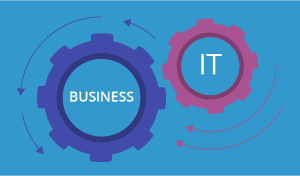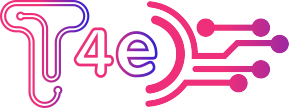Business-IT Alignment And Marketing Strategy: Challenges and Rewards:
In today’s dynamic and technology-driven business landscape, the synergy between an organization’s business objectives and its Information Technology (IT) capabilities is essential for sustained success. Achieving this alignment, however, is a journey filled with both challenges and rewards. In this exploration, we delve into the intricacies of Business-IT alignment, uncovering the obstacles that businesses face and the invaluable benefits that await those who conquer these challenges. Join us as we navigate the ever-evolving realm of technology and business, where the alignment of these two forces promises to unlock innovation, efficiency, and competitive advantage.


Why your IT strategy must align with your business strategy?
Your IT strategy must align with your business strategy because it’s the digital backbone that empowers and amplifies your organization’s ability to execute, innovate, and thrive in today’s dynamic landscape. Just as a ship’s course is set by its compass, your IT strategy serves as the guiding technology compass that ensures your business navigates successfully through the complexities of the modern world.


- Enhancing Efficiency: When your IT strategy aligns with your business strategy, it streamlines operations, automates processes, and optimizes resource allocation. This efficiency not only saves time and money but also ensures that your business can adapt swiftly to changing market conditions.
- Facilitating Innovation: IT innovation often drives business innovation. A well-aligned IT strategy enables you to leverage emerging technologies, harness big data, and implement cutting-edge solutions. This, in turn, allows your organization to stay competitive and even become a leader in your industry.
- Enabling Data-Driven Decision-Making: In the data-driven age, having an IT strategy that aligns with your business strategy is essential. It ensures that you collect and analyze the right data to make informed decisions. This, in turn, leads to better strategic planning and a deeper understanding of your customers and markets.
-
Improving Customer Experience:
- Your IT systems are often the interface between your business and your customers. A harmonized IT and business strategy enables you to create seamless and personalized customer experiences. It allows you to meet customer expectations and demands while remaining agile and responsive.
- Managing Risks: The alignment of IT and business strategies is critical for risk management. Cybersecurity, data privacy, and regulatory compliance are paramount concerns in today’s business landscape. A cohesive strategy helps you implement robust security measures and ensures that your IT infrastructure remains resilient against threats.
- Fostering Scalability: As your business grows, your IT needs to scale proportionally. When both strategies align, you can expand your IT infrastructure without disruption, ensuring that your technology can keep pace with your business’s growth trajectory.
- Ensuring Resource Allocation: Resources are finite, and an aligned strategy ensures that IT investments are made where they have the most impact on achieving your business objectives. It prevents wasteful spending on IT projects that do not contribute to your core goals.
In a nutshell, a well-aligned IT strategy is the enabler that translates your business strategy into tangible results. It empowers your organization to adapt, innovate, and thrive in a rapidly evolving digital world. In today’s business landscape, the convergence of business and IT strategies is not just an advantage; it’s a necessity for sustainable success.
Why IT and business strategies become misaligned?
IT and business strategies can become misaligned for a multitude of reasons, and the intricate interplay between technology and business dynamics creates a landscape ripe for such misalignment. Here are some unique factors contributing to this disconnect:


- Rapid Technological Advancements: The breakneck pace of technological innovation often leads to misalignment. Businesses may formulate strategies based on existing technologies, but the IT landscape evolves so rapidly that these strategies can quickly become obsolete. This disconnect occurs because IT departments struggle to keep up with the latest advancements while adhering to long-term business strategies.
- Unpredictable External Factors: Geopolitical events, economic fluctuations, and unforeseen global crises can throw a wrench into the best-laid plans. Such unpredictable external factors can disrupt business operations, making it difficult for IT departments to align their strategies with ever-changing business priorities.
- Communication Challenges: Misalignment frequently stems from poor communication between IT and business units. The jargon and technical complexities of IT can create a communication barrier, making it challenging for non-technical stakeholders to understand the potential and limitations of technology, thereby leading to conflicting strategies.
-
Budget Constraints:
- Limited budgets can force IT departments to prioritize cost-effective solutions that may not align with broader business goals. Short-term cost-cutting measures can result in suboptimal IT investments, leading to misalignment with long-term business strategies.
- Siloed Organizational Structure: In organizations with rigid silos, different departments may develop their strategies in isolation. This lack of cross-functional collaboration can lead to misalignment, as IT projects are often intertwined with various business functions and require holistic integration to be effective.
- Mismatched Talent and Skillsets: A shortage of skilled IT professionals or a disconnect between the skills available within an organization and those required for strategic IT initiatives can hinder alignment. In some cases, the scarcity of talent in emerging tech areas can limit the realization of strategic IT goals.
- Resistance to Change:Business strategies may involve significant changes in processes, workflows, or employee roles. Employees might resist these changes due to fear of job insecurity or reluctance to adopt new technologies, causing IT and business strategies to diverge.
- Vendor Lock-In: Overreliance on specific vendors or proprietary technologies can limit an organization’s flexibility to adapt to changing business needs. Vendor lock-in can create a disconnect when IT strategies are dictated by vendor roadmaps rather than business objectives.
- Regulatory and Compliance Challenges: Evolving regulations and compliance requirements can lead to IT strategies that prioritize meeting legal mandates over business innovation. This trade-off can cause misalignment when IT departments focus on regulatory compliance at the expense of business growth.
- Lack of Strategic Vision: Sometimes, either IT or business units may lack a clear,Marketing Strategy, long-term strategic vision, leading to ad-hoc decision-making. This can result in fragmented efforts that do not align with broader organizational goals.
How business leaders can use IT to the fullest?
Business leaders can use IT to the fullest by leveraging technology to drive innovation, efficiency, and strategic growth. Here are some key points in a bullet-point format:
- Align IT with Business Objectives:
- Ensure that IT initiatives are closely aligned with the overall business strategy.
- Prioritize IT investments that directly contribute to achieving business goals.
- Embrace Digital Transformation:
- Embrace digital transformation as a means to optimize processes and create new revenue streams.
- Encourage the adoption of digital technologies to enhance customer experiences and operational efficiency.
- Foster a Culture of Innovation:
- Promote a culture of innovation by encouraging employees to explore new technologies and ideas.
- Create an environment where calculated risks are taken to drive technological innovation.
- Invest in IT Talent:
- Attract and retain top IT talent to ensure the organization has the skills required for technology-driven success.
- Provide ongoing training and professional development opportunities for IT staff.
- Data-Driven Decision Making:
- Utilize data analytics and business intelligence tools to make informed decisions.
- Leverage data to gain insights into customer behavior, market trends, and operational efficiency.
- Collaborate Across Departments:
- Promote cross-functional collaboration between IT and other business units.
- Encourage IT to work closely with marketing, sales, and operations to develop integrated solutions.
- Implement Cloud Solutions:
- Utilize cloud computing to improve scalability, Marketing Strategy ,reduce infrastructure costs, and enhance flexibility.
- Adopt cloud-based applications for increased agility and accessibility.
- Cybersecurity Prioritization:
- Prioritize cybersecurity to protect sensitive data and maintain customer trust.
- Invest in robust cybersecurity measures and educate employees on security best practices.
-
Customer-Centric Approach:
- Use IT to gather and analyze customer data for personalization and tailored marketing efforts.
- Implement customer relationship management (CRM) systems to improve customer engagement and satisfaction.
- Automation and AI Integration:
- Explore automation and artificial intelligence (AI) solutions to streamline repetitive tasks and improve productivity.
- Integrate AI into customer service, decision support, and operational processes.
- Scalable IT Infrastructure:
- Ensure that IT infrastructure is scalable to accommodate business growth.
- Plan for future technology needs and invest in adaptable solutions.
- Stay Informed About Technology Trends:
- Stay informed about emerging technology trends and their potential impact on the industry.
- Attend technology conferences and engage with IT experts to remain up-to-date.
- Measure and Optimize IT Performance:
- Implement Key Performance Indicators (KPIs) to measure the effectiveness of IT initiatives.
- Continuously optimize IT strategies based on performance data and feedback.
- Regulatory Compliance:
- Stay informed about regulatory changes that impact the industry and IT operations.
- Ensure IT systems and practices comply with relevant regulations.
- Risk Management:
- Develop a comprehensive risk management strategy to address potential IT-related risks.
- Plan for contingencies and disaster recovery to minimize business disruptions.
- Feedback and Adaptation:
- Encourage feedback from employees, customers, and stakeholders to make IT improvements.
- Be flexible and adapt IT strategies in response to changing market dynamics.
By following these strategies, business leaders can harness the power of Marketing Strategy to drive growth, innovation, and competitiveness within their organizations.
What technology leaders can do for business and IT alignment?
- Establish a Clear Vision:
- Define a clear and compelling vision for how technology can support and drive the business’s strategic goals.
- Effective Communication:
- Foster open, transparent, and ongoing communication between IT and business units to ensure a shared understanding of objectives.
- Cross-Functional Collaboration:
- Encourage collaboration and partnerships between IT and business teams, breaking down silos and promoting synergy.
- IT Governance Framework:
- Implement an IT governance framework that aligns IT decision-making with business priorities and ensures accountability.
- Strategic Planning:
- Develop an IT strategic plan that is closely tied to the organization’s overall strategic plan, outlining technology’s role in achieving business goals.
- KPIs and Metrics:
- Establish key performance indicators (KPIs) and metrics that reflect the impact of IT initiatives on the business and regularly assess their performance.
- Change Management:
- Provide change management support to help employees adapt to new technologies and processes.
- Skill Development:
- Invest in training and development programs to enhance the technology skills of both IT Marketing Strategy and non-IT staff.
-
Innovation Culture:
- Cultivate an organizational culture that encourages innovation and experimentation, with IT at the forefront.
- Customer-Centric Focus:
- Prioritize technology initiatives that enhance the customer experience, aligning with customer-centric business strategies.
- Vendor and Technology Evaluation:
- Regularly assess the suitability of technology vendors and solutions to ensure they align with business needs.
- Data Governance:
- Establish data governance practices that ensure data quality, security, and compliance with business requirements.
- Agile Project Management:
- Adopt agile project management methodologies to increase flexibility and responsiveness in IT project delivery.
- Regular Review Meetings:
- Schedule regular meetings between business and IT leaders to review progress, discuss challenges, and adapt strategies accordingly.
- Cost Management:
- Monitor IT costs and ensure that technology investments are in line with the budget and provide value to the business.
- Cybersecurity Alignment:
- Ensure that IT security practices are closely aligned with the organization’s risk management and compliance strategies.
- Feedback Mechanisms:
- Establish feedback mechanisms for employees and customers to provide input on IT-related services and experiences.
- Continuous Improvement:
- Promote a culture of continuous improvement within IT to enhance the alignment process over time.
- Scenario Planning:
- Engage in scenario planning to anticipate and adapt to potential changes in technology and market dynamics.
- Adaptive Technology Roadmaps:
- Create flexible technology roadmaps that can adapt to evolving business needs and technological advancements.
By implementing these strategies, technology leaders can play a pivotal role in achieving and maintaining alignment between IT and the broader business objectives, driving innovation, efficiency, Marketing Strategy and growth.
conclusion:
In conclusion, the alignment of business and IT is a dynamic and critical aspect of modern organizations. While challenges may exist, the potential rewards are substantial. Marketing Strategy By recognizing the importance of aligning business and IT strategies, understanding the reasons behind misalignment, and embracing strategies for achieving alignment, businesses can harness technology as a powerful tool for innovation, efficiency, and competitiveness in an ever-evolving digital landscape. It is the harmonious fusion of business vision and Marketing Strategy capabilities that propels organizations toward success and sustainable growth.
